12 Essential Tools for AdWords Competitor Analysis in 2025

Maxime Dupré
10/13/2025
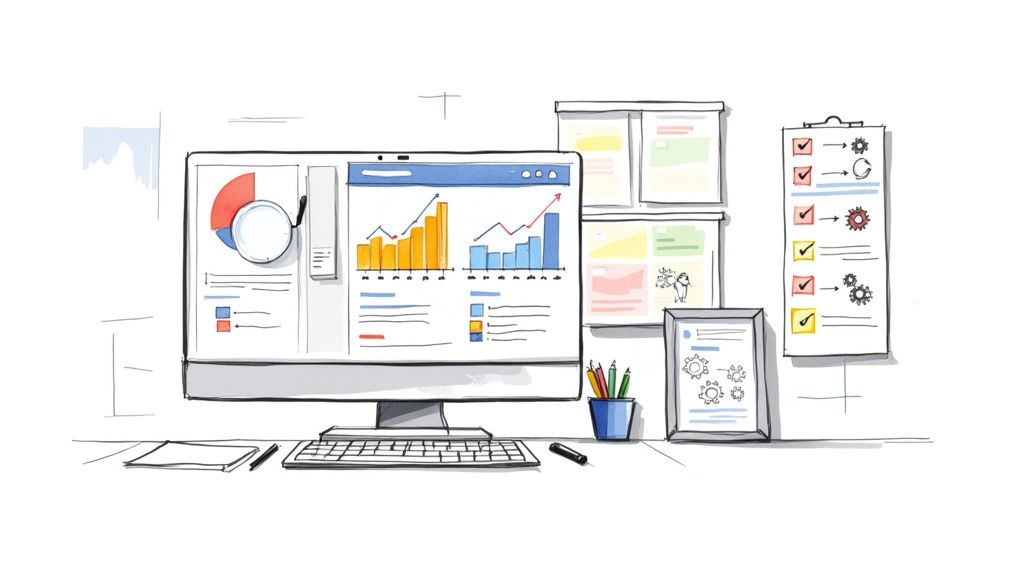
Running successful Google Ads campaigns often feels like navigating a crowded market blindfolded. You know your competitors are out there, but what are they actually doing? What keywords are they bidding on? Which ad copy is winning them clicks, and how much are they spending to acquire customers? This is where a robust AdWords competitor analysis strategy moves from a 'nice-to-have' to an absolute necessity for growth.
Instead of relying on assumptions, a systematic analysis gives you a direct view into your rivals' playbooks. This process reveals critical opportunities to outmaneuver them, optimize your ad spend, and capture valuable market share. To truly move 'beyond guesswork' in understanding your rivals, it's crucial to learn the fundamentals of how to conduct competitor analysis effectively. Mastering this foundation allows you to turn competitive data into a strategic advantage.
This guide is your blueprint for uncovering that data. We will walk through 12 essential platforms and websites designed to lift the curtain on your competitors' PPC activities. Forget generic feature lists; for each tool, we provide screenshots, direct links, practical use cases, and an honest assessment of its limitations. Whether you're a founder trying to make every dollar count or an SMB looking to scale, this resource will help you select the right tools and turn raw competitor data into smarter, data-driven decisions for your campaigns.
1. ChampSignal
ChampSignal presents a compelling and highly efficient solution for modern AdWords competitor analysis, positioning itself as a standout choice for founders, marketing leads, and agile teams. Its core strength lies in its ability to deliver high-signal, actionable intelligence by automating the most time-consuming aspects of monitoring. Instead of requiring users to manually sift through data, the platform uses AI and statistical outlier detection to filter out insignificant changes, ensuring every alert is genuinely noteworthy. This approach allows teams to maintain constant situational awareness without dedicating hours to manual research.
The setup process is remarkably fast, taking just one minute to start tracking competitors across a comprehensive range of channels. This includes not only Google Ads but also website changes, keyword rankings, backlink profiles, and even brand mentions on Reddit. This multi-channel view is crucial for a holistic understanding of a competitor's strategy, moving beyond just ad copy to see the full marketing ecosystem at play.
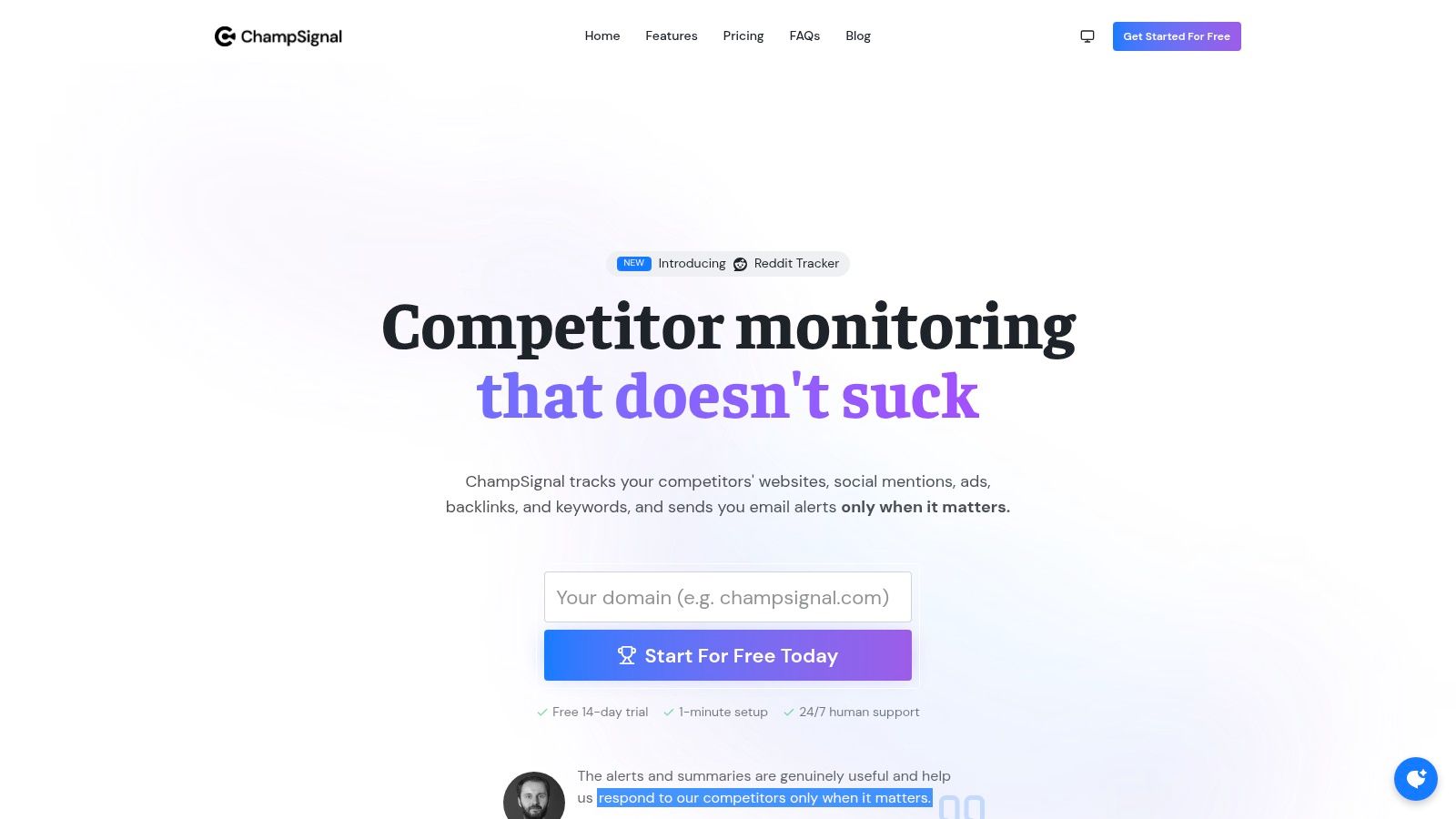
Key Features and Strategic Use Cases
ChampSignal's feature set is designed for strategic action rather than simple data collection. The platform excels at identifying when a competitor launches a new ad campaign, significantly alters their bidding strategy, or starts targeting a new set of keywords.
- Google Ads Monitoring: Receive immediate alerts when a competitor launches a new ad, changes ad copy, or adjusts their targeting. This enables you to quickly analyze their messaging and positioning.
- AI-Powered Alert Filtering: Its most significant differentiator is the use of AI to cut through the noise. You are only notified of statistically significant events, such as a major shift in ad spend or a new high-value backlink, which prevents alert fatigue.
- Cross-Channel Intelligence: By correlating AdWords data with website updates and keyword ranking shifts, you can uncover broader strategic pivots. For example, a new ad campaign launching alongside a new landing page signals a major product or marketing initiative.
- Historical Change Tracking: The platform maintains a detailed log of all competitor activities, providing valuable context for analyzing long-term trends and understanding the evolution of their marketing strategy.
Practical Implementation
Best For: SMBs, startups, and founders who need a powerful, automated competitor intelligence system that requires minimal configuration.
ChampSignal offers flexible pricing, starting at $33 per month for tracking up to 5 competitors and scaling to $83 per month for 15 competitors. All plans include a 14-day free trial and a 30-day money-back guarantee, making it a risk-free option to evaluate. While the standard plans have competitor limits, enterprise needs can be accommodated by contacting their responsive human support team, which is available 24/7. The platform’s focus on streamlined, high-impact alerts makes it an exceptional tool for any team looking to turn competitor data into a decisive strategic advantage.
Website: https://champsignal.com
2. Semrush – Advertising Research
Semrush stands as a titan in the digital marketing intelligence space, and its Advertising Research toolkit is a cornerstone for any serious AdWords competitor analysis. It offers a comprehensive suite for dissecting your rivals' paid search strategies, from keyword targeting to ad creative and budget allocation. The platform excels at providing a holistic view by integrating paid search data with organic search, backlink, and content marketing insights, a feature that distinguishes it from more narrowly focused PPC tools.
The user experience is robust, with data-rich dashboards that allow you to quickly identify a competitor's top paid keywords, view their live ad copy, and analyze the landing pages driving their conversions. This integrated workflow is its greatest strength; you can uncover a competitor's PPC keyword gap, then immediately pivot to analyze their SEO strategy for the same terms without leaving the platform.
Key Features & Use Cases
- Paid Keyword Discovery: Uncover the exact keywords competitors are bidding on, along with estimated CPC, search volume, and traffic share. This is crucial for finding new keyword opportunities and understanding market dynamics.
- Ad Copy & History: Analyze historical and current ad examples. This feature allows you to track how a competitor’s messaging evolves over time, revealing their promotional calendar and A/B testing patterns.
- Spend & Traffic Estimation: Gain insight into a competitor's estimated monthly ad spend and the traffic it generates, helping you benchmark your own budget and performance.
Limitations and Considerations
While incredibly powerful, Semrush's professional-grade toolkit comes with a higher price tag compared to tools aimed at smaller businesses. Furthermore, some of the most advanced analytics, such as its market and traffic intelligence modules, are sold as separate add-ons, increasing the total investment.
For a deeper dive into leveraging this tool, you can explore detailed guides on paid search intelligence.
Semrush is best suited for marketing teams who need a unified solution for managing SEO and PPC competitor research in one place.
Website: https://www.semrush.com
3. SpyFu
SpyFu has carved out a niche as a highly specialized tool for PPC competitor research, with a laser focus on Google Ads. It is particularly revered for its deep historical data, allowing users to track a competitor's AdWords strategy over many years. This long-term perspective is invaluable for understanding how rivals have adapted to market changes, tested messaging, and adjusted their budgets over time.
Its core strength lies in its straightforward approach to AdWords competitor analysis. SpyFu excels at revealing the most profitable keywords in your market, showing you which ones your competitors are bidding on, and even providing downloadable templates of their most successful ad copy. The platform is designed for quick, actionable insights, making it a favorite among agencies and small to medium-sized businesses that need to move fast without getting bogged down in overly complex analytics.
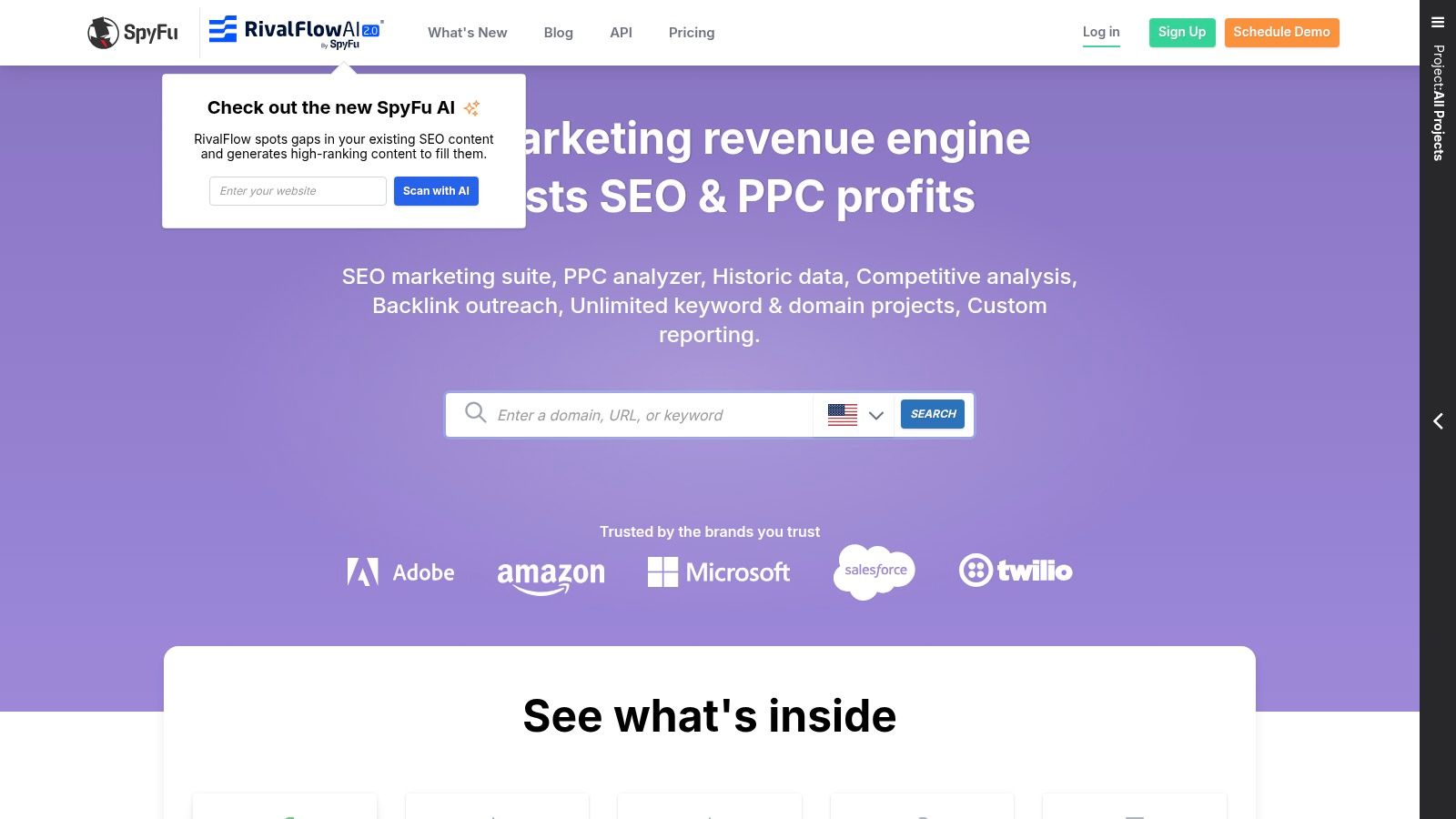
Key Features & Use Cases
- PPC Keyword Research: Enter a competitor’s domain to see every keyword they've bid on, every ad variation they've run, and every ranking they’ve achieved in the last 15+ years (on Pro plans).
- AdWords Templates & "Kombat": The "Kombat" feature lets you compare your keyword profile against two competitors, instantly identifying common keywords and exclusive opportunities. The platform also offers ad buy recommendations.
- Historical Data: Access to over a decade of data reveals long-term strategic shifts, seasonality, and the historical performance of specific ad campaigns, providing a unique strategic advantage.
Limitations and Considerations
While powerful, SpyFu's user interface is more utilitarian than polished, which may present a learning curve for some users. The granularity and accuracy of its data can also vary depending on the niche, with more popular industries generally having richer datasets. However, its straightforward pricing and unlimited data exports on most plans offer exceptional value.
SpyFu's "Ad History" feature is a goldmine for reverse-engineering a competitor's promotional calendar and split-testing strategies.
The tool is an excellent choice for PPC specialists and agencies who prioritize deep, historical Google Ads data and need to generate actionable insights quickly.
Website: https://www.spyfu.com
4. Similarweb – Web/Ads Intelligence
Similarweb provides an enterprise-grade digital intelligence platform where AdWords competitor analysis is situated within a broader context of web traffic and market trends. It offers a powerful cross-channel view, allowing users to analyze competitor search and display ad strategies alongside their overall digital footprint. The platform excels at benchmarking performance against the wider market, providing traffic share data and audience insights that go beyond typical PPC-only tools.
The user experience is tailored for strategic analysis, with dashboards that visualize complex datasets, from ad spend distribution to publisher partnerships. Similarweb's key differentiator is its ability to blend paid search intelligence with comprehensive web analytics. You can analyze a competitor's ad keywords and then immediately investigate the referral traffic, social media engagement, and audience demographics that contribute to their overall success, all within a unified interface.
Key Features & Use Cases
- Search & Display Ad Analysis: Investigate competitor ad creatives, landing pages, and the publishers they work with. This is ideal for understanding their full advertising ecosystem, not just their search presence.
- Rank Tracker & SERP Analysis: Monitor keyword positions over time with historical SERP data. This helps in identifying long-term strategic shifts in a competitor's paid and organic efforts.
- Country-Level Filters & AI Insights: Segment analysis by specific international markets and leverage AI agents to automate the discovery of strategic insights, saving significant manual research time.
Limitations and Considerations
Similarweb's extensive capabilities come with a price tag that positions it primarily for enterprise clients and large agencies. Access to certain advanced modules and detailed data often requires direct contact with their sales team, making it less accessible for smaller businesses or those needing a quick, self-serve solution.
For businesses operating at scale, Similarweb's integrated view of a competitor's entire digital strategy offers a level of market intelligence that standalone PPC tools cannot match.
Similarweb is best suited for organizations that require a holistic market and competitive intelligence platform where paid search is one component of a larger digital strategy.
Website: https://www.similarweb.com
5. iSpionage
iSpionage is a competitive intelligence platform built with the PPC manager in mind, offering a laser-focused suite of tools for AdWords competitor analysis. It excels at uncovering the complete user journey, from the keyword a competitor bids on to the ad copy they use and the landing page that converts the visitor. This direct, conversion-focused approach makes it a favorite among agencies and in-house PPC specialists who need actionable data quickly.
Its interface is streamlined for paid search workflows, enabling users to quickly identify a competitor's most profitable terms using the proprietary Ad Effectiveness Index (KEI). Unlike broader marketing suites, iSpionage dedicates its resources to PPC and SEM, providing granular insights into campaign structures and local advertising efforts that are often harder to find in all-in-one tools.
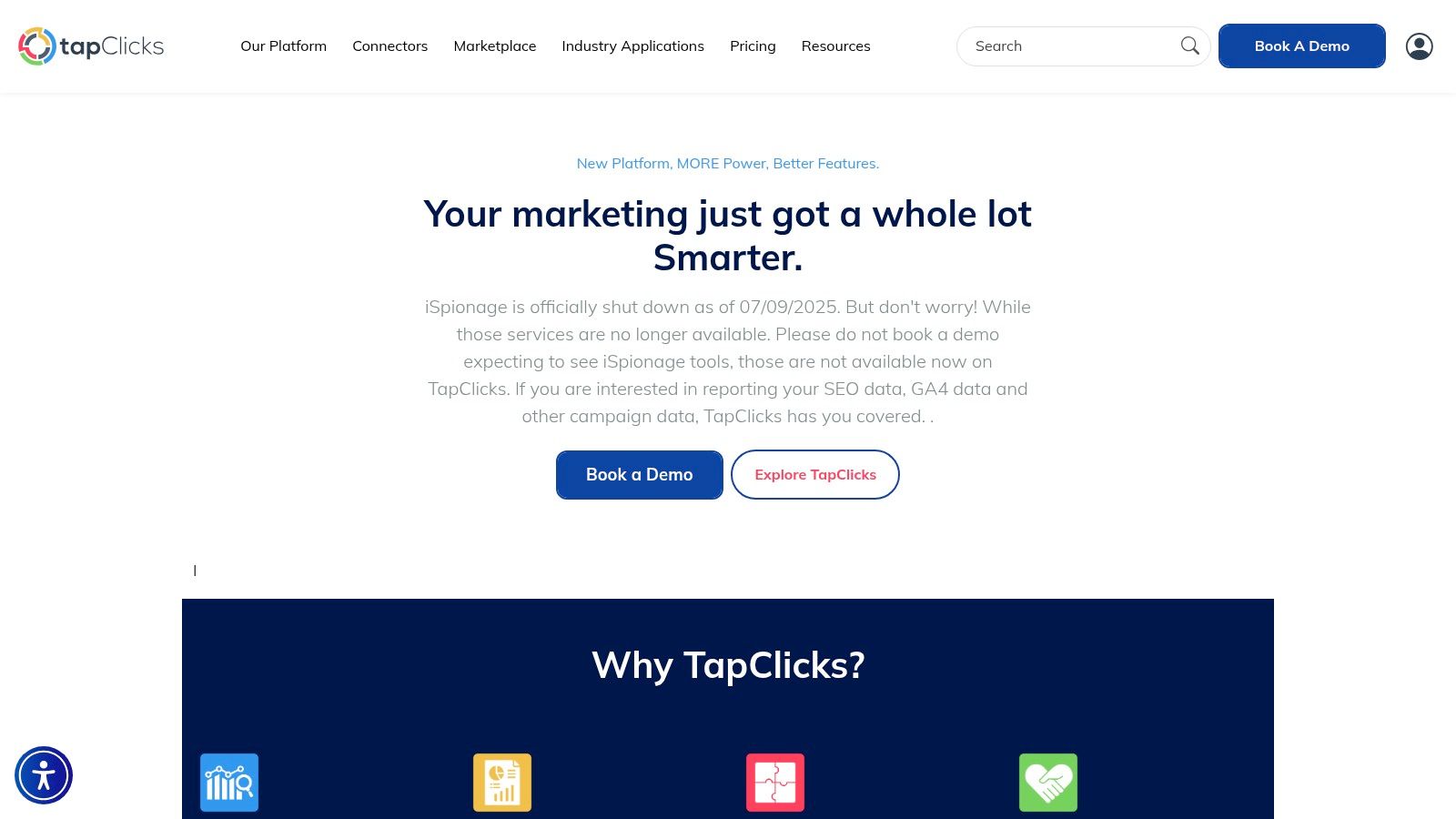
Key Features & Use Cases
- Ad & Landing Page Discovery: View a competitor’s ad copy and the corresponding landing pages side-by-side. This is invaluable for understanding their funnel strategy and conversion rate optimization tactics.
- SEM Campaign Watch: Set up alerts to monitor specific competitors. iSpionage will notify you of new keywords they start bidding on or changes in their ad copy, allowing for real-time strategic adjustments.
- Competitor Keyword Gap Analysis: Easily find high-value keywords your competitors are bidding on that you aren't, presenting clear opportunities to expand your reach and capture market share.
Limitations and Considerations
While powerful, iSpionage's most comprehensive data is centered on the US, UK, and Canadian markets, which may be a limitation for global campaigns. Additionally, some of its most valuable features, like historical data and advanced campaign monitoring, are reserved for higher-tier subscription plans.
The platform's lower entry price point makes it an accessible yet powerful tool for small agencies and businesses focusing primarily on Google Ads intelligence.
iSpionage is best for PPC professionals who require a dedicated, affordable tool for deep-diving into competitor ad funnels without the complexity of a full marketing suite.
Website: https://www.ispionage.com
6. Serpstat – PPC Research
Serpstat positions itself as an all-in-one growth hacking tool, and its PPC Research module offers a powerful yet accessible entry point for AdWords competitor analysis. It provides a solid foundation for analyzing rivals' paid search campaigns by revealing their keywords, ad copy, and landing page strategies. Serpstat’s main differentiator is its balance of functionality and affordability, making it an attractive option for startups, SMBs, and marketers who need a versatile SEO and PPC tool without the enterprise-level price tag.
The platform's user interface is clean, presenting key PPC metrics in a straightforward manner. Its Domain vs. Domain feature is particularly useful for a direct, side-by-side comparison of your paid keyword strategy against a competitor's, quickly highlighting gaps and overlaps. This streamlined approach makes it easy to extract actionable insights without getting lost in overly complex data sets.
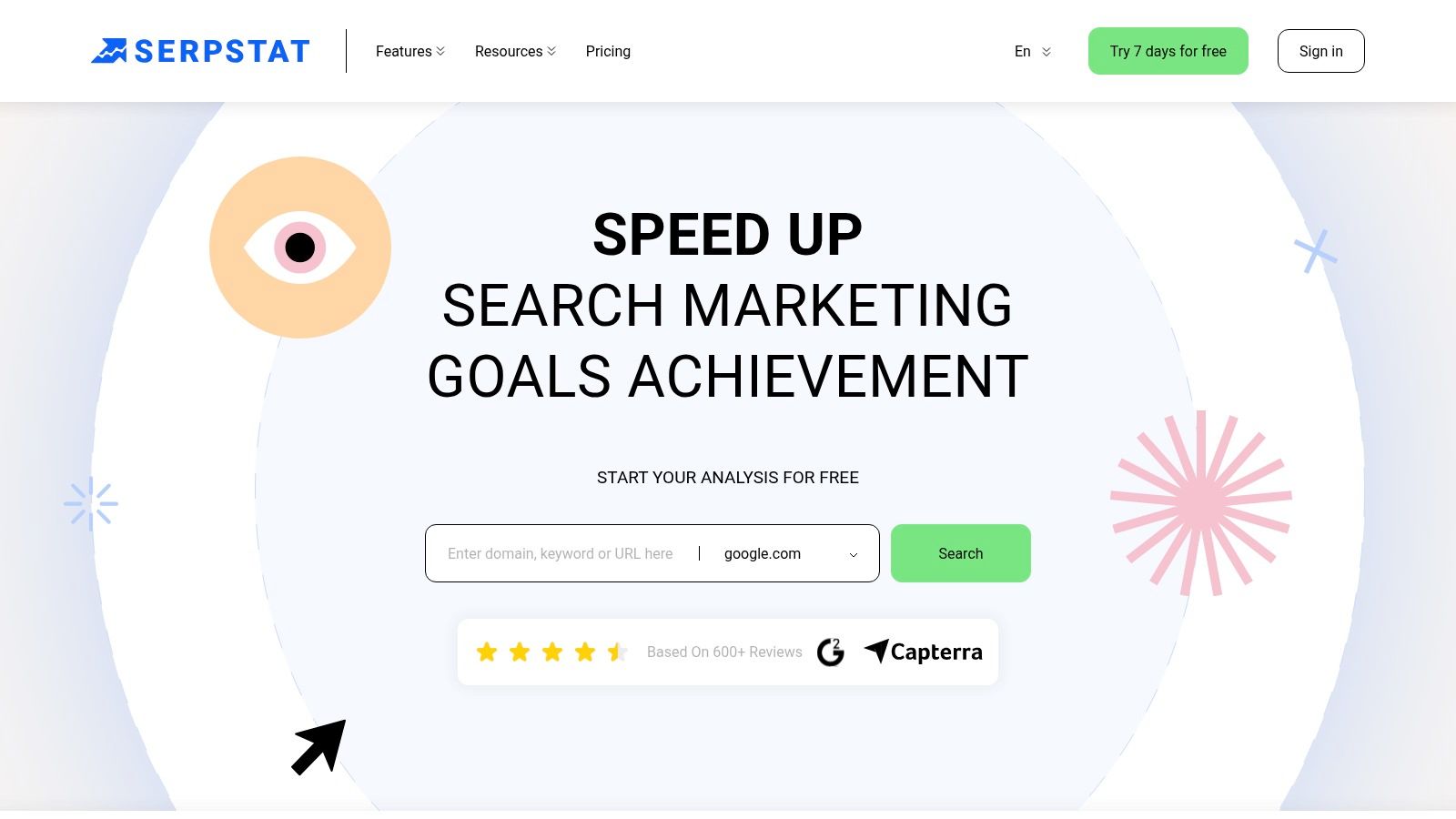
Key Features & Use Cases
- PPC Keyword Research: Identify the keywords your competitors are bidding on, view live ad examples, and analyze the CPC and competition level for those terms. This is essential for discovering profitable keywords you may have overlooked.
- Domain vs. Domain Analysis: Directly compare your PPC keyword portfolio against up to two competitors to instantly find common keywords and unique opportunities where their strategy differs from yours.
- Ad Research & History: Examine competitor ad copy to understand their messaging, unique selling propositions, and promotional tactics. This helps you craft more compelling ads for your own campaigns.
Limitations and Considerations
While Serpstat offers great value, its PPC data may not be as deep or extensive as what you'd find in more specialized, PPC-centric platforms. The historical data and volume of ad examples might be more limited compared to higher-priced competitors, which could be a factor for agencies managing large-scale campaigns.
For a deeper understanding of how to apply these insights, you can review guides on a complete competitive PPC analysis.
Serpstat is best suited for marketing professionals and SMBs looking for a cost-effective, multi-purpose tool that combines robust SEO features with essential PPC competitor analysis capabilities.
Website: https://serpstat.com
7. SE Ranking – Competitor SEO/PPC Research
SE Ranking has carved out a strong position as an all-in-one SEO and PPC platform, offering a highly accessible Competitor Research tool that is particularly valuable for blended marketing teams. It provides a clean, user-friendly interface to dissect competitor AdWords strategies, making it less intimidating than some enterprise-level suites. The platform's core strength lies in its balance of comprehensive SEO features with growing PPC analysis capabilities, all delivered through a flexible and often more affordable pricing structure.
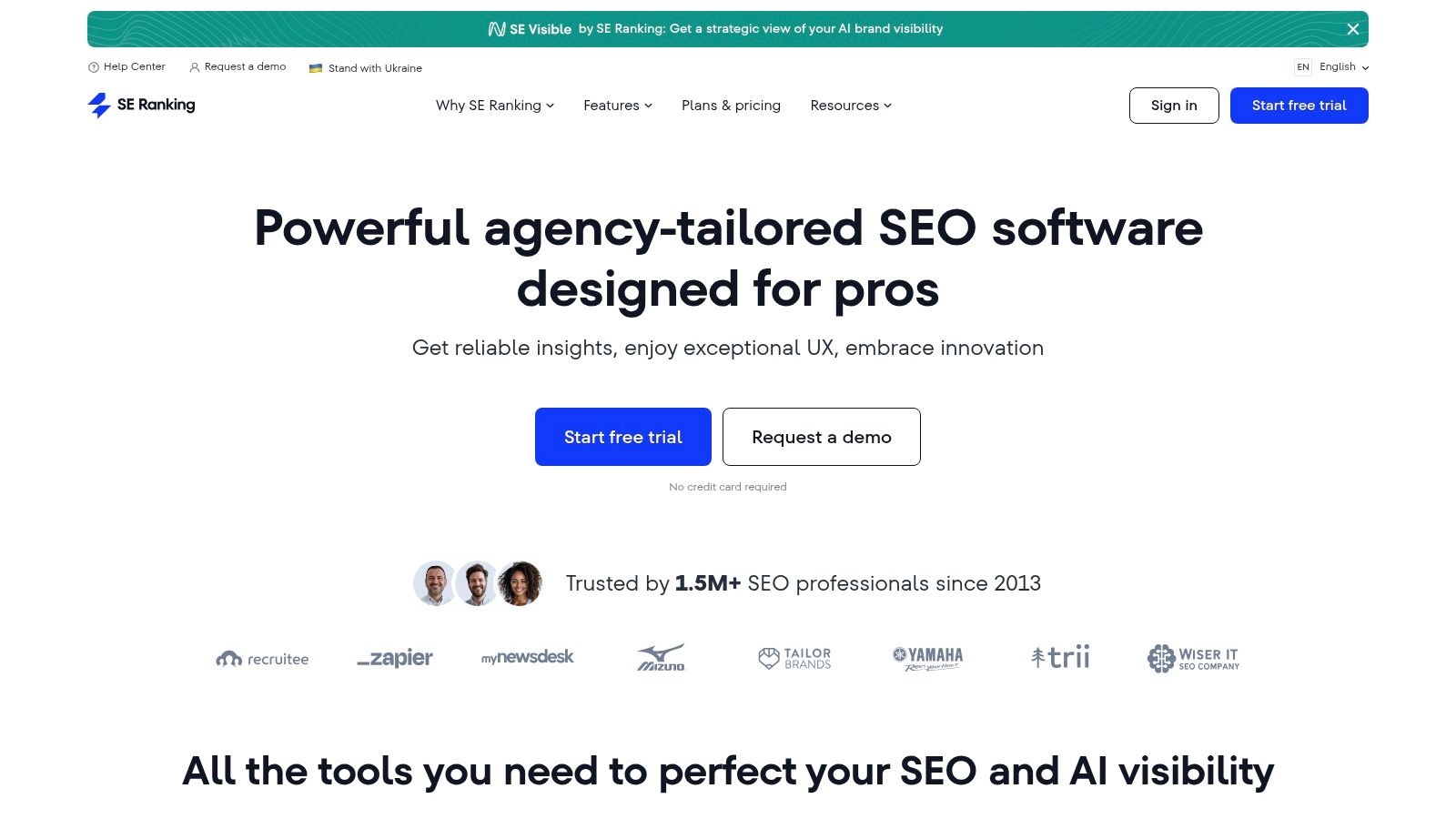
The platform allows you to quickly pull up a competitor's domain and view their paid keywords, ad examples, and estimated traffic and budget data. While its historical data is still expanding, the quality of its US market database is solid. This makes it a great choice for SMBs and agencies that need reliable AdWords competitor analysis without committing to the highest-tier pricing of more established players in the space.
Key Features & Use Cases
- PPC Keyword Lists & Ad History: Easily extract the keywords a competitor is bidding on and review their ad copy history. This is essential for identifying keyword gaps and understanding their promotional messaging and offer evolution.
- Traffic & Page Analysis: Analyze a competitor's top pages by paid traffic to see which landing pages are performing best, providing crucial insights for your own campaign structure and conversion optimization.
- Looker Studio Integration: Higher-tier plans offer integration with Looker Studio (formerly Google Data Studio), allowing you to build custom, shareable dashboards that combine competitor PPC data with your own performance metrics.
Limitations and Considerations
While its PPC toolkit is robust and continually improving, it may not yet possess the same depth of historical data or the granular filtering options found in platforms that specialize exclusively in PPC intelligence. Its strength is in its integrated SEO/PPC approach rather than being the most powerful standalone PPC tool.
SE Ranking's value proposition is its blend of powerful features with a flexible pricing model, making advanced competitor analysis more attainable for a wider range of businesses.
This tool is ideal for marketing professionals and agencies looking for a cost-effective, unified platform to manage both SEO and PPC competitor research.
Website: https://seranking.com
8. Adbeat
Adbeat offers a specialized lens for competitive ad intelligence, focusing heavily on display, native, and video advertising channels. While not a direct AdWords tool, it provides invaluable complementary data for a comprehensive AdWords competitor analysis by revealing a rival's cross-channel creative strategy. Understanding the visuals, messaging, and landing pages used in their display campaigns on networks like Google Display Network and YouTube can inform and inspire your own search ad copy and creative direction.
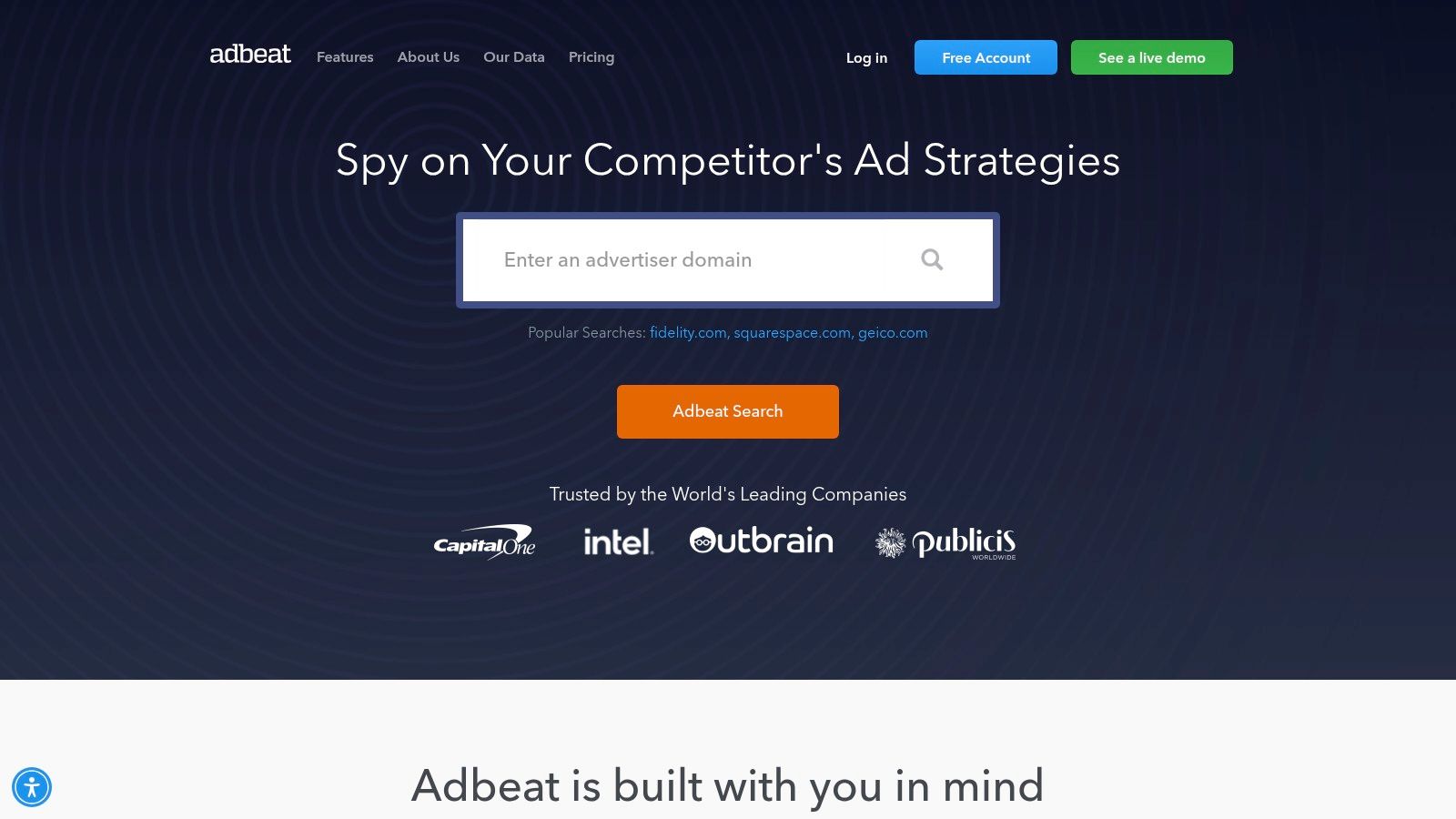
The platform's strength is its visual-first approach, allowing you to quickly browse a competitor's entire creative library across various networks. This focus on display and native advertising provides a unique angle, showing how brands are attracting top-of-funnel traffic before those users ever make a branded or high-intent search, giving you insight into their broader digital footprint.
Key Features & Use Cases
- Creative & Placement Intelligence: See the exact display, native, and video ads competitors are running and where they are placing them. This is essential for understanding their messaging angles and target publisher sites.
- Cross-Network Coverage: Analyze campaigns across major networks, including Google Display Network, YouTube, Taboola, and Outbrain, providing a holistic view of a competitor's non-search advertising efforts.
- Historical Ad Data: Track a competitor’s creative evolution over time to identify seasonal promotions, A/B tests, and long-term strategic messaging shifts.
Limitations and Considerations
Adbeat’s core focus is on display and native ads, so it doesn't provide the deep keyword-level data for Google Search ads that platforms like Semrush do. Its professional pricing is not publicly listed, requiring a demo, and its greatest value is realized by teams managing both search and display advertising campaigns who need to align their strategies.
For a deeper understanding of how this tool fits into a broader strategy, you can find more information about competitive advertising analysis.
Adbeat is best suited for advertisers seeking to align their search and display strategies by gathering deep creative and placement intelligence on their competitors.
Website: https://www.adbeat.com
9. Adthena
Adthena is an enterprise-grade competitive intelligence platform designed for the complexities of large-scale paid search advertising. It leverages AI to provide a "whole market view," moving beyond direct competitor tracking to map out the entire competitive landscape for your target keywords. This approach makes it exceptionally powerful for advertisers in highly regulated or saturated verticals like finance, pharma, and retail, where brand protection and granular insights are paramount.
The platform's core strength lies in its ability to deliver location-specific and strategic group-level insights, helping enterprise teams manage complex, multi-market campaigns. Adthena's AI-driven categorization of the market helps you discover not just direct rivals but also indirect or emerging threats, which is a key part of a sophisticated AdWords competitor analysis strategy.
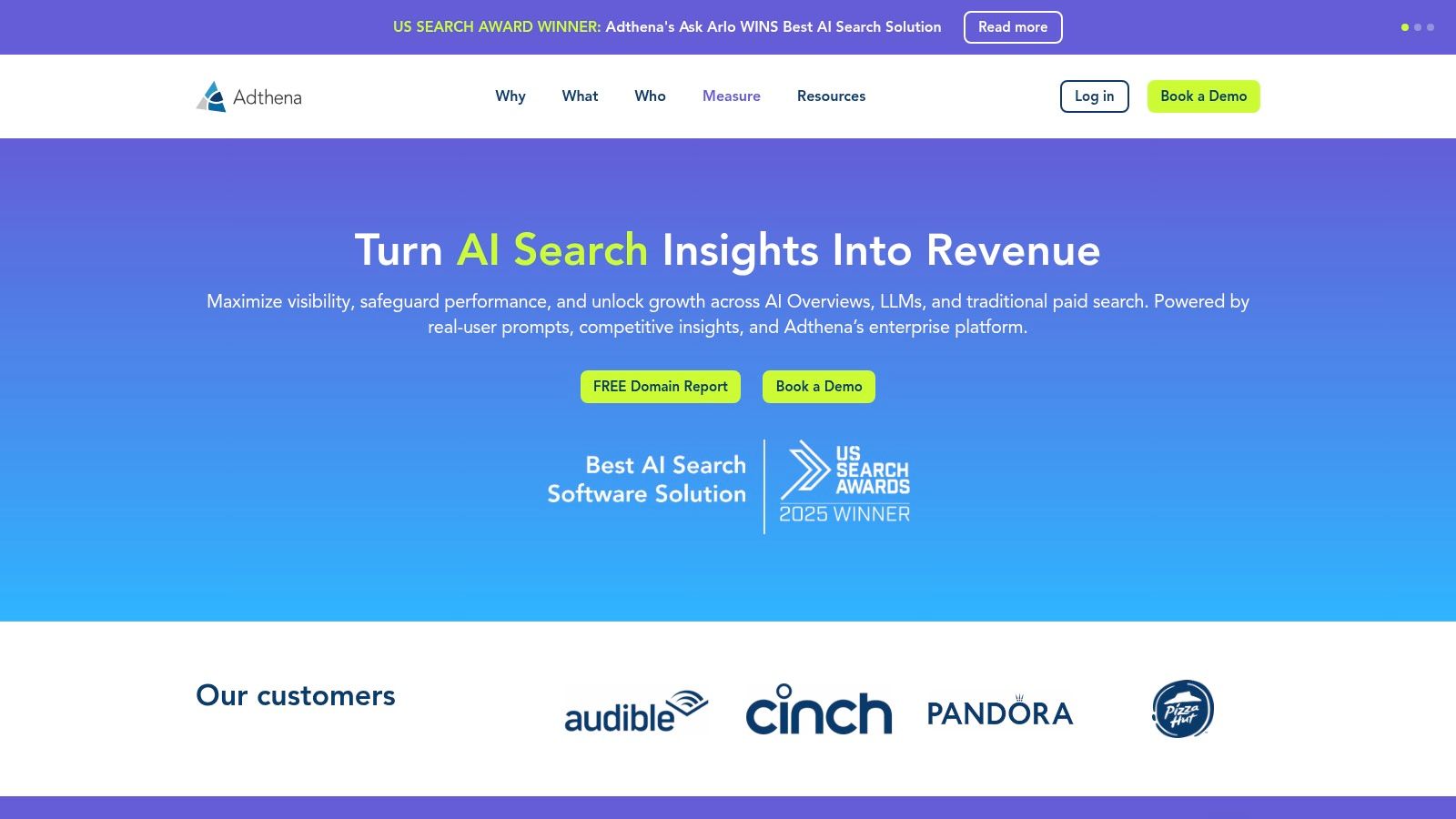
Key Features & Use Cases
- Whole Market View: Maps the entire search landscape to identify every competitor bidding on your terms, not just the ones you are already tracking. This is ideal for market share analysis and identifying new threats.
- Brand Protection & Trademark Monitoring: Automatically detects and reports on competitors bidding on your branded and trademarked terms, a critical feature for brand governance and reducing CPC inflation.
- Smart Monitor Alerts: Provides automated alerts for significant changes in the competitive landscape, such as new entrants or aggressive bidding from existing rivals, allowing for rapid strategic adjustments.
- Local & DMA-Level Insights: Delivers granular competitive data down to the Designated Market Area (DMA) level, which is essential for businesses with a strong regional or local focus.
Limitations and Considerations
Adthena is squarely aimed at the enterprise market, with custom pricing and a sales-led onboarding process. There is no self-serve option or free trial, which makes it inaccessible for small to mid-sized businesses or those wanting to quickly test the platform. Its focus is purely on paid search, so it lacks the integrated SEO and content marketing features found in broader suites.
By providing a complete view of the auction landscape, Adthena helps you understand your true market share and defend your brand against every type of competitor.
Adthena is best suited for large, sophisticated advertising teams that require deep, AI-powered insights and robust brand protection tools for their AdWords competitor analysis.
Website: https://www.adthena.com
10. The Search Monitor
The Search Monitor carves out a specialized niche in AdWords competitor analysis by focusing on high-frequency, granular ad monitoring and brand protection. It's designed for enterprises and regulated industries that require precise, real-time data on how their ads and their competitors' ads appear across different geographic locations and devices. The platform’s core strength lies in its compliance and enforcement capabilities, making it indispensable for brands needing to police trademark bidding by affiliates and competitors.
Unlike all-in-one marketing suites, The Search Monitor is a surgical tool for deep paid search intelligence. It uses geo-targeted crawlers to capture a true picture of the search engine results page (SERP), providing accurate data on ad copy, rank, and market share that isn't skewed by a user's personal search history. This precision is crucial for advertisers in highly competitive or legally sensitive markets.
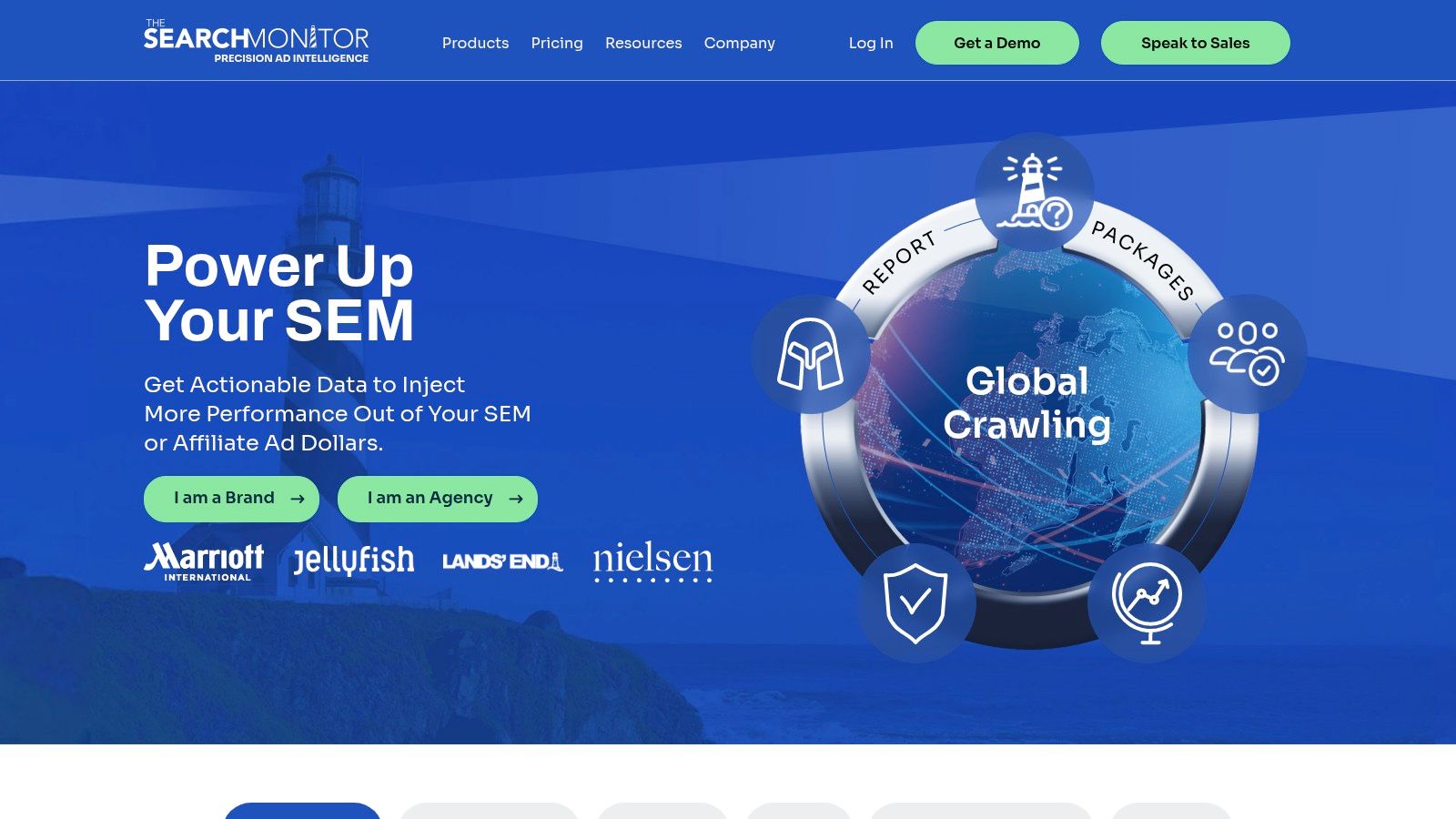
Key Features & Use Cases
- Geo-targeted Ad Monitoring: See exactly how your and your competitors' ads are displayed in specific cities, states, or countries. This is essential for local service businesses and global brands managing regional campaigns.
- Brand & Affiliate Compliance: Automatically detect and report on unauthorized trademark bidding, direct linking, or non-compliant ad copy from partners and competitors, protecting brand integrity and ad spend.
- Share of Voice & Visibility Scores: Track your market visibility against key rivals, analyzing who owns the top ad positions for your most important keywords and how their strategy changes over time.
Limitations and Considerations
The Search Monitor's specialized focus and enterprise-grade data come with premium pricing, placing it outside the budget of many small to mid-sized businesses. Its interface is highly data-driven and less focused on the integrated SEO and content marketing features found in broader platforms like Semrush or Ahrefs.
Its real power lies in providing evidence-based intelligence for enforcement, helping legal and marketing teams protect their trademarks with automated takedown workflows.
This tool is best for large advertisers, agencies, and brands in regulated industries that prioritize compliance and granular, geo-specific competitive monitoring.
Website: https://www.thesearchmonitor.com
11. PPC Ad Lab
PPC Ad Lab is a specialized competitor discovery tool built with a strong focus on live Google Ads data, catering particularly to marketing agencies. Its unique selling proposition is providing real-time insights into Search, Shopping, and even Local Services Ads (LSAs), an area often underserved by larger platforms. This focus on live data makes it an excellent choice for dynamic, fast-moving local markets where competitor ad strategies can change daily.
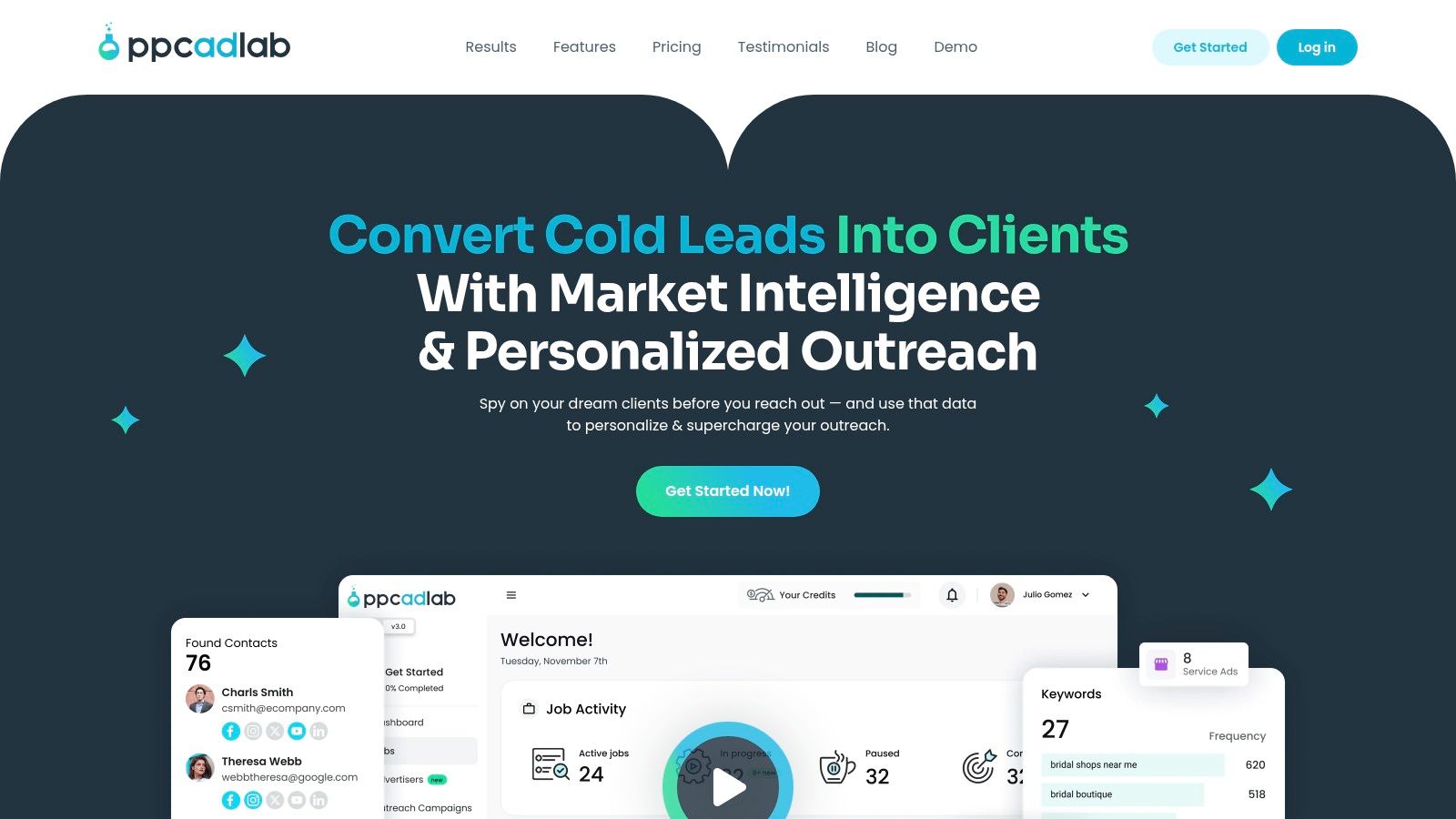
The platform's user experience is streamlined and agency-centric, integrating lead generation and outreach functionalities directly into the workflow. After performing AdWords competitor analysis to identify new players or aggressive campaigns, users on higher-tier plans can immediately look up contact information and initiate cold email sequences. This transforms the tool from a pure analysis platform into a business development engine for agencies.
Key Features & Use Cases
- Live SERP & LSA Monitoring: Get real-time views of what ads are running for your target keywords across Search, Shopping, and Local Services Ads, crucial for local SEO and PPC campaigns.
- Agency Prospecting Tools: Higher-tier plans include features for finding contact information for advertisers you discover, alongside cold email outreach capabilities to streamline new client acquisition.
- Historical Ad Tracking: Monitor how a competitor's ad copy, offers, and landing pages change over time to identify their promotional strategies and testing patterns.
Limitations and Considerations
PPC Ad Lab is a newer and more niche tool compared to established all-in-one suites, so its feature set outside of direct ad monitoring is less extensive. The built-in outreach tools, while powerful for agencies, may represent an unnecessary expense for in-house marketing teams who only need the core competitor analysis functions.
The platform's tight integration of competitive analysis with direct outreach offers a unique workflow for agencies looking to grow their client base by demonstrating market expertise.
PPC Ad Lab is best suited for marketing agencies focused on local markets or those who want a unified tool for both ad intelligence and new business prospecting.
Website: https://ppcadlab.com
12. Google (First-party) – Ads Transparency Center + Auction Insights
Leveraging Google's own tools is the most direct and foundational step in any AdWords competitor analysis. The combination of the public-facing Ads Transparency Center and the in-platform Auction Insights report provides unimpeachable, first-party data. While other tools offer estimations and broader analytics, these Google resources deliver ground-truth information straight from the source, making them essential for validating assumptions and understanding your immediate auction environment.
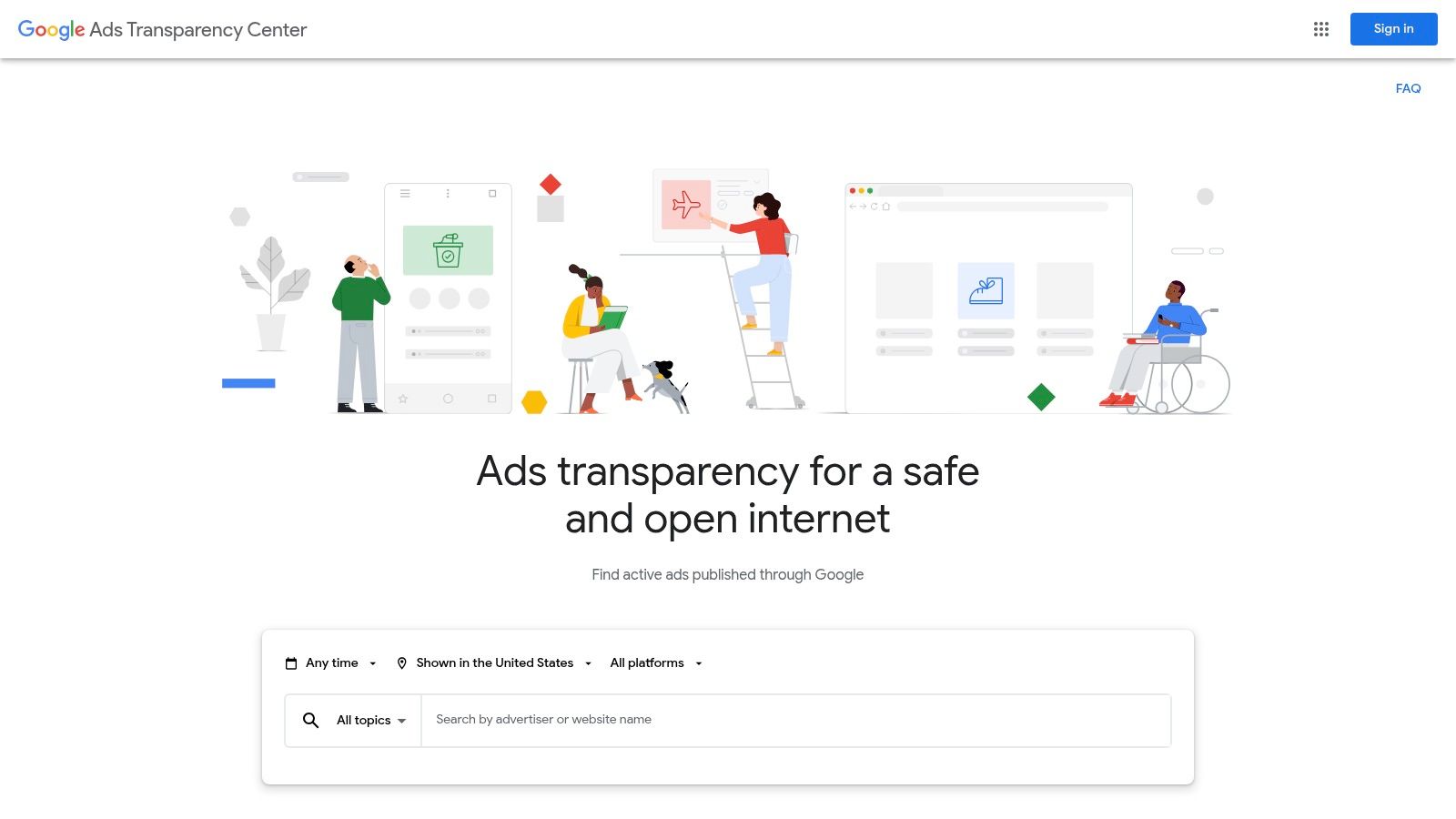
The primary strength of this pairing is its authenticity and accessibility. The Ads Transparency Center allows anyone to search for an advertiser and see the ads they have run across Google's network, offering a direct look at their creative and messaging. Auction Insights, available within your Google Ads account, provides real-time competitive metrics, showing you exactly who you are competing against in the auctions that matter most to you and how you stack up.
Key Features & Use Cases
- Ad Creative Verification: Use the Ads Transparency Center to view a competitor's active ad formats (Search, Display, YouTube) and messaging. This is perfect for analyzing their current offers, calls-to-action, and brand positioning.
- Auction-Level Benchmarking: Access Auction Insights to see your impression share, overlap rate, and position-above rate against specific domains. This helps diagnose performance drops and identify aggressive new entrants.
- No-Cost Data: Both tools are completely free to use, providing a baseline of competitive intelligence for advertisers of any size without requiring a subscription to a third-party platform.
Limitations and Considerations
The major drawback is the separation and simplicity of the data. The Ads Transparency Center offers no performance metrics like spend or traffic, and its data is not exportable for deeper analysis. Similarly, Auction Insights data is confined to the Google Ads UI, with no official API or direct Looker Studio connector, making historical trend analysis cumbersome.
These first-party tools provide a non-negotiable starting point; they show you what's actually happening in your specific ad auctions, a perspective no other tool can perfectly replicate.
Google's native tools are best for advertisers who need to validate third-party data and get a quick, accurate snapshot of their direct auction competitors and ad creative.
Website: https://adstransparency.google.com
AdWords Competitor Analysis Tools Comparison
| Platform | Core Features/Capabilities | User Experience & Quality ★ | Value & Pricing 💰 | Target Audience 👥 | Unique Selling Points ✨ |
|---|---|---|---|---|---|
| 🏆 ChampSignal | Multi-channel competitor tracking (web, Reddit, Ads, SEO); AI noise filtering | ★★★★☆ Intuitive 1-min setup; 24/7 support | $33-$83/mo; scalable plans; free trial | Founders, SMBs, Teams | AI-powered alerts; customizable sensitivity; full historical tracking |
| Semrush – Advertising Research | PPC keyword, ad copy, spend, seasonality analysis | ★★★★ Broad data, strong integrations | Higher-end; some add-ons extra | US/global marketers | Integrated SEO + PPC toolkit |
| SpyFu | PPC keyword & ad history; 10+ years historical data | ★★★☆ Utilitarian UI; unlimited exports | Clear pricing; strong value | Agencies, SMBs | Long-term data; downloadable templates |
| Similarweb – Web/Ads Intelligence | Cross-channel ad analysis; traffic benchmarking | ★★★★ Enterprise-grade, team-friendly | Enterprise pricing | Enterprises, global teams | AI insights; broad digital intelligence |
| iSpionage | Keyword gap, ad copy, local SEM monitoring, alerts | ★★★☆ Focused UI; some gated features | Lower entry price | PPC managers, small agencies | SEM Campaign Watch; alerts |
| Serpstat – PPC Research | PPC keyword & ad examples; domain comparison; tutorials | ★★★☆ Budget-friendly, actionable content | Competitive pricing; free trial | Budget-conscious PPC users | SEO + PPC in one; tutorials |
| SE Ranking – Competitor SEO/PPC Research | Paid keywords, ad history, traffic estimates; Looker Studio integration | ★★★★ User-friendly; expanding data | Flexible pricing | PPC & SEO teams | Blended SEO/PPC focus |
| Adbeat | Display, native & video ad creative and placement history | ★★★★ Creative-focused insights | Pro price not public | Teams doing display & search | Cross-network creative intelligence |
| Adthena | AI-powered whole market paid search; brand protection; local insights | ★★★★ Enterprise-level | Custom enterprise pricing | Regulated/competitive verticals | Brand protection; Smart Monitor alerts |
| The Search Monitor | Paid search/ad compliance; geo-targeted monitoring; brand enforcement workflows | ★★★★ High-frequency data, custom reports | Premium pricing | Brand protection teams | Automated takedowns; geo-targeting |
| PPC Ad Lab | Live Google Ads, Shopping insights; lead lookup, white-label | ★★★☆ Fast setup; agency-focused | Affordable; 14-day trial | Agencies, local markets | Lead generation & outreach tools |
| Google (First-party) – Ads Transparency | Ad visibility; auction insights; free official tools | ★★★★ Ground-truth data; limited metrics | Free | All advertisers | Direct from Google; free baseline competitor data |
From data to decision: Turning your analysis into action
The journey through the landscape of AdWords competitor analysis tools, from all-in-one suites like Semrush and SpyFu to specialized platforms like Adbeat and Adthena, reveals a powerful truth: data is only the starting point. The real competitive advantage isn't found in a spreadsheet full of keywords or a folder of ad copy screenshots. It’s forged in the deliberate, strategic actions you take based on that intelligence.
We've explored how to uncover your rivals' top-performing keywords, deconstruct their ad copy, analyze their landing pages, and even estimate their budgets. But letting this valuable research sit idle is the most common pitfall. The market doesn't stand still, and neither do your competitors. A one-time analysis provides a snapshot; a continuous monitoring process delivers a significant, sustainable edge.
Synthesizing Insights into Strategy
Your goal is to transform isolated data points into a cohesive strategy. After conducting your initial deep-dive using the tools we’ve discussed, your focus should shift to answering high-level strategic questions. This is where your AdWords competitor analysis evolves from a tactical exercise into a growth driver.
Organize your findings around these core pillars:
- Keyword Opportunities: Did you find high-intent keywords where competitors are active, but you are not? Are they bidding on branded-plus terms (e.g., "competitor name + alternative") that you could counter?
- Ad Copy & Messaging Gaps: What unique selling propositions (USPs) are your competitors hammering home? Is their messaging centered on price, features, or support? Identify the angles they are not using and test them in your own campaigns.
- Landing Page Experience: Do competitors offer a more streamlined user experience post-click? Is their call-to-action clearer or their lead capture form simpler? A superior ad can be completely undermined by a poor landing page.
- Offer & Promotion Strategy: Are rivals consistently running promotions, discounts, or limited-time offers? This can signal their customer acquisition strategy and help you decide whether to compete on price or differentiate on value.
Establishing a Cadence for Continuous Improvement
The most successful advertisers treat competitor analysis not as a project, but as an ongoing process. The digital advertising space is too dynamic for a "set it and forget it" mindset. Establish a regular, manageable cadence for review.
- Weekly Check-in (15-30 minutes): A quick scan for major changes. Are there new, high-volume campaigns? Has a key competitor suddenly gone dark on a top keyword? Automated tools like ChampSignal are invaluable here, as they push critical alerts directly to you.
- Monthly Review (1-2 hours): A more thorough look at trends. How has competitor ad copy evolved? Are they testing new landing pages? Have their keyword priorities shifted?
- Quarterly Deep-Dive (4-8 hours): A comprehensive refresh of your initial analysis. Re-evaluate who your primary competitors are, benchmark your performance against them, and set strategic goals for the next quarter.
This structured approach ensures you’re always operating with current information, allowing you to react swiftly to threats and proactively seize opportunities.
Beyond Analysis: Crafting Your Response
Once you've identified a competitor's winning tactic, the next step is crafting an effective response. This involves more than just copying their ad text. It requires creativity and strategic thinking. AI-powered tools can be a fantastic partner in this process, helping you brainstorm compelling alternatives. For instance, exploring various ChatGPT prompts tailored for digital marketers can help you generate fresh ad copy variations, reframe value propositions, or even outline new landing page concepts based on competitor weaknesses you've uncovered.
Ultimately, the goal of a robust AdWords competitor analysis is to empower you to make smarter, faster, and more profitable decisions. It’s about understanding the battlefield so you can choose where and how to compete. By integrating the right tools and, more importantly, the right processes, you can transform competitive intelligence from a defensive necessity into your most potent offensive weapon.
Ready to turn competitor monitoring from a manual chore into an automated advantage? ChampSignal delivers high-signal alerts on your competitors' ad strategies directly to your inbox, so you can stop searching and start acting. Try ChampSignal and see what moves your rivals are making today.
Get Started
Competitor Monitoring That Doesn't Suck
Spend under two minutes per week monitoring your competitors. Receive only the information that matters.
Join startup founders two steps ahead of their competition.

